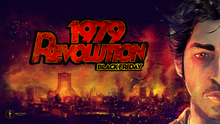My experiences streaming and the potential of Twitch as a public platform
During this past summer I had the opportunity to be a Research Assistant for the Digital Iran project, funded by the Simpson Center for the Humanities. Part of my responsibilities included me live-streaming myself playing and analyzing video games about Iran, all while engaging a live audience. As someone who had very little experience playing video games, I was ready for the unique challenge but I was not sure what to expect. I knew that the gaming community can be full of toxicity, especially targeted towards women, and much of that took place on Twitch, as well as not being an experienced video game player. I started by playing the simplest of the four games: 1979 Revolution: Black Friday. Essentially a docu-video game created by Iranians in the diaspora to bring awareness and understanding on the Iranian Revolution, I found myself to be emotionally moved by the game. Different characters in the game represented different aspects of the revolution, and in order to mimic real life choices you only have seconds to make decisions that will impact what happens in the game. I found many different aspects of the game interesting given our current political climate—mass protests, militarized police, journalists documenting crimes, etc. The events in the game, despite being an animated game, felt both real in emotion and relevant to the current state of our world.

The next game I played was Battlefield 3, a first-person shooter where the US is engaging in a war in Iraq and Iraq, and other various locations. Where 1979 Revolution: Black Friday’s intentions were to build compassion and understanding, this game served as a stark contrast. Battlefield 3 is considered to be the most visually accurate video game made about Iran, but even then seeing backwards Arabic in Tehran or unusual translations of things were common. I found the game to be adrenaline inducing and very stressful. The game itself had little dialogue or background information as to why the US was invading these countries or what the conflict was about, it was merely presented as a “US good, Middle East bad” narrative. While unsurprising for a video game made in the US marketed towards young men, I found the game dehumanizing for people in the Middle East and promoted US imperialism.

The other two games I played were Prince of Persia: Sands of Time and Garshasp: The Monster Slayer. While both are similar games in game play, both third person action adventure video games, they are completely different in how they were made by the game creators and received by players. Whereas Prince of Persia is completely an orientalist fantasy, complete with scantily clad damsels in distress, exotic locations, and exaggerated villains, Garshasp was a game created in Iran by Iranians about one of the heros in the Shahnahmeh—a Persian epic poem. Prince of Persia remains to this day a popular game, and its subsequent franchise is a household name, whereas Garshasp remains less popular. I personally felt affect to be less significant while playing these two games, potentially due to the game being in the third-person as well as focused on completing puzzles rather than being fully encompassed in the gameworld.

I was completely surprised by my experience as the RA for this project. My apprehension around playing video games and my worry that I would not be any good was quickly washed away and, in at least the first two games, I found myself fully immersed in the game world. In 1979 Revolution: Black Friday, I was able to feel some of the emotions the characters felt—sadness, anxiety, empathy for other characters, and second guessing the choices I made in the game. In Battlefield 3, I felt intense, at times overwhelming, adrenaline as I completed each mission. As for Prince of Persia and Garshasp, I felt less of the emotional embodiment that I felt in the first two games—both while playing and as a whole. Though experiences while playing video games are highly personal, I suspect for myself this is in part due to the 3-person nature of the games that lacked the feature of the characters being almost like a surrogate for your experience. Regardless, all of the games served as an important insight and analysis into the embodied thinking and perceptions of Iran by both game players and creators.

